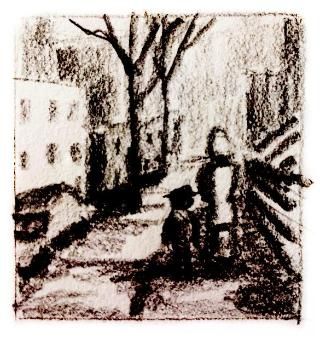Asher Lev Discussion Guide: Part 1

Epigraph through Chapter 2
Dr. David McNutt (Core Studies) and Dr. Tiffany Kriner (English)
Epigraph
The novel uses as its epigraph a line from Picasso: “Art is a lie which makes us realize the truth.” Does that bear out in your experience of the arts?
Chapters 1-2
In the opening chapters, we are introduced to the primary tension in Asher’s life: his artistic gift and calling places him in conflict with his family and the broader Hasidic Jewish community. We also learn about the work of Asher’s parents, which plays out against the backdrop of international politics. Meanwhile, Asher moves through several stages of growth: expressing his artistic talent as a precocious boy, burying his gift for a time, and finally having his interest rekindled.
- From the opening paragraphs, we know that Asher, the “notorious and legendary” artist, will embrace his artistic calling, decide to paint a crucifixion, and find himself in conflict with his Jewish community. How does knowing this about Asher set up your experience as a reader?
- Asher describes himself as an “observant Jew” (3) and opens the first chapter of his defense of himself with a history of his family’s Jewish lineage; we also see evidence of his participation in Jewish practices: attending synagogue (10, 74); celebrating Shabbos (11) and Hanukkah (11); studying the Talmud (11). How would you describe his place in the Jewish community at this early stage?
- Asher’s name means “happy” or “blessed.” In what ways do you think Asher is blessed or is a blessing to his family and community?
- Asher’s parents express concerns about his artistic interests. His mother, Rivkeh, wants Asher to make “pretty” drawings (8, 17-18). She asks, “Can it make a difference?” (18). And his father, Aryeh, thinks that art is “foolishness” (12) or “playing” (35). What does this reveal about their views of art? How does the young Asher respond to their views? What seem to be his early ideas about what art does in the world (19, 36)?
- Suffering and death seem to be part of Asher’s life from the beginning: he recounts the death of his grandfather (5); his uncle, Yaakov, dies in a car accident (14); his mother struggles with paralyzing grief. He also absorbs the suffering of the community around him to greater and lesser degrees. What are some examples of the local and global community’s suffering that arise? How do these experiences shape Asher as an artist?
- Asher’s father travels for the Rebbe to support Jewish communities in Eastern Europe, and his mother decides to continue her brother’s “unfinished” work (21, 46). How do these callings compare to Asher’s artistic interests?
- Despite his parents’ concerns about his art, Asher finds some glimpses of support within both his family and the community: his Uncle Yitzchok buys one of his drawings (32); he finds art supplies at Yudel Krinsky’s store (68, 81, 85). What is the role of the community in identifying an individual’s gifts and calling?
